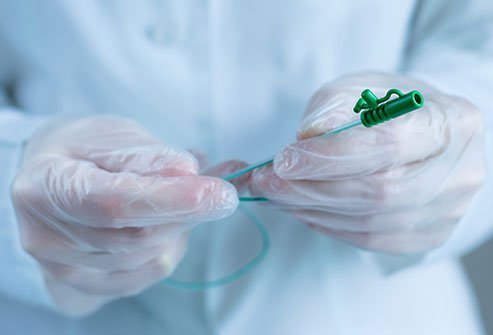
Urinary diversion is a surgical procedure of creating a new way for the urinary exit when the urine flow is obstructed or blocked.
Urinary diversion is bypassing the normal structures in the urinary tract and creating an alternative way for the flow of urine through either a replacement bladder (neobladder) or an opening in the abdominal wall (stoma).
2 types of urinary diversions
- Noncontinent urinary diversion
- Urostomy: It is the most common type of urinary diversion done. A stoma or an opening in the abdomen is created that connects the urinary tract to allow the urine to drain from the body, which is collected and stored in a small bag called a urostomy pouch. This pouch is attached to the skin around the stoma and worn outside the body.
- Ileal conduit: A passage for urine is made by surgical removal of a piece of the intestine and attaching the ureters to the piece of intestine, which is further attached to an opening in the abdomen, creating a stoma.
- Cutaneous ureterostomy: A direct attachment of one or both the ureters to a stoma in the abdomen.
- Bladder catheterization: It involves inserting a catheter (a thin, flexible tube) into the bladder to drain urine into a collection bag outside the body.
- The two types of urinary catheters include:
- Foley catheter: Inserted into the bladder through the urethra.
- Suprapubic catheter: Inserted into the bladder through a small hole in the skin beneath the belly button.
- The two types of urinary catheters include:
- Cystostomy: A surgical procedure wherein a small tube is inserted into the bladder through the skin of the lower abdomen, which allows the urine to drain from the bladder into a bag outside the body.
- Nephrostomy: A tiny incision is made to insert a small tube, called a nephrostomy tube, through the skin of the back into the kidney, which allows the urine to drain from the kidney into a bag outside the body.
- Ureteral stent: A thin flexible tube guided with a cystoscope is inserted into the ureter to help urine flow from the kidney to the bladder.
- Urostomy: It is the most common type of urinary diversion done. A stoma or an opening in the abdomen is created that connects the urinary tract to allow the urine to drain from the body, which is collected and stored in a small bag called a urostomy pouch. This pouch is attached to the skin around the stoma and worn outside the body.
- Continent urinary diversion: An internal pouch created from part of the bowel or in the bladder collects and stores the urine inside the body until it is drained using a catheter.
- Continent cutaneous reservoir: A piece of bowel is used to create an internal pouch or reservoir to hold the urine and is placed inside the abdomen. The ureters are attached to the internal pouch wherein the urine is collected and drained by using a catheter.
- Bladder substitute or neobladder: A piece of bowel is used to create an internal reservoir called a bladder substitute or neobladder to hold the urine and is placed in the pelvis. The ureters are attached to the bladder substitute, and the bladder substitute is attached to the urethra through which a person can urinate.
What is urinary diversion?
Urinary diversion is a surgical procedure of creating a new way for the urinary exit when the urine flow is obstructed or blocked or there is a need to bypass a diseased area in the urinary tract.
Urinary diversion can be:
- Temporary: The flow of urine is rerouted for several days, weeks, or sometimes, months.
- Permanent: Surgical procedure is performed to create a permanent change to the way urine flows through the body.
The urinary tract or the drainage system of the body includes organs, such as the kidneys, ureters, bladder, and urethra. This drainage system is designed to remove the urine, which is made of toxic wastes and extra fluids.
If normal urine flow is obstructed, it may lead to the accumulation of toxic waste products in the urinary tract and may cause pain, urinary tract infections, urinary stones, or calculi, damage to the urinary tract, or a life-threatening complication, such as kidney failure.

SLIDESHOW
Urinary Incontinence in Women: Types, Causes, and Treatments for Bladder Control See Slideshow
Medically Reviewed on 4/27/2022
References
Cleveland Clinic. Urinary Reconstruction & Diversion. https://my.clevelandclinic.org/health/treatments/12546-urinary-reconstruction–diversion
Bladder & Bowel Community. Urinary Diversion. https://www.bladderandbowel.org/surgical-treatment/urinary-diversion/
Urology Care Foundation. Urinary Diversion. https://www.urologyhealth.org/urology-a-z/u/urinary-diversion